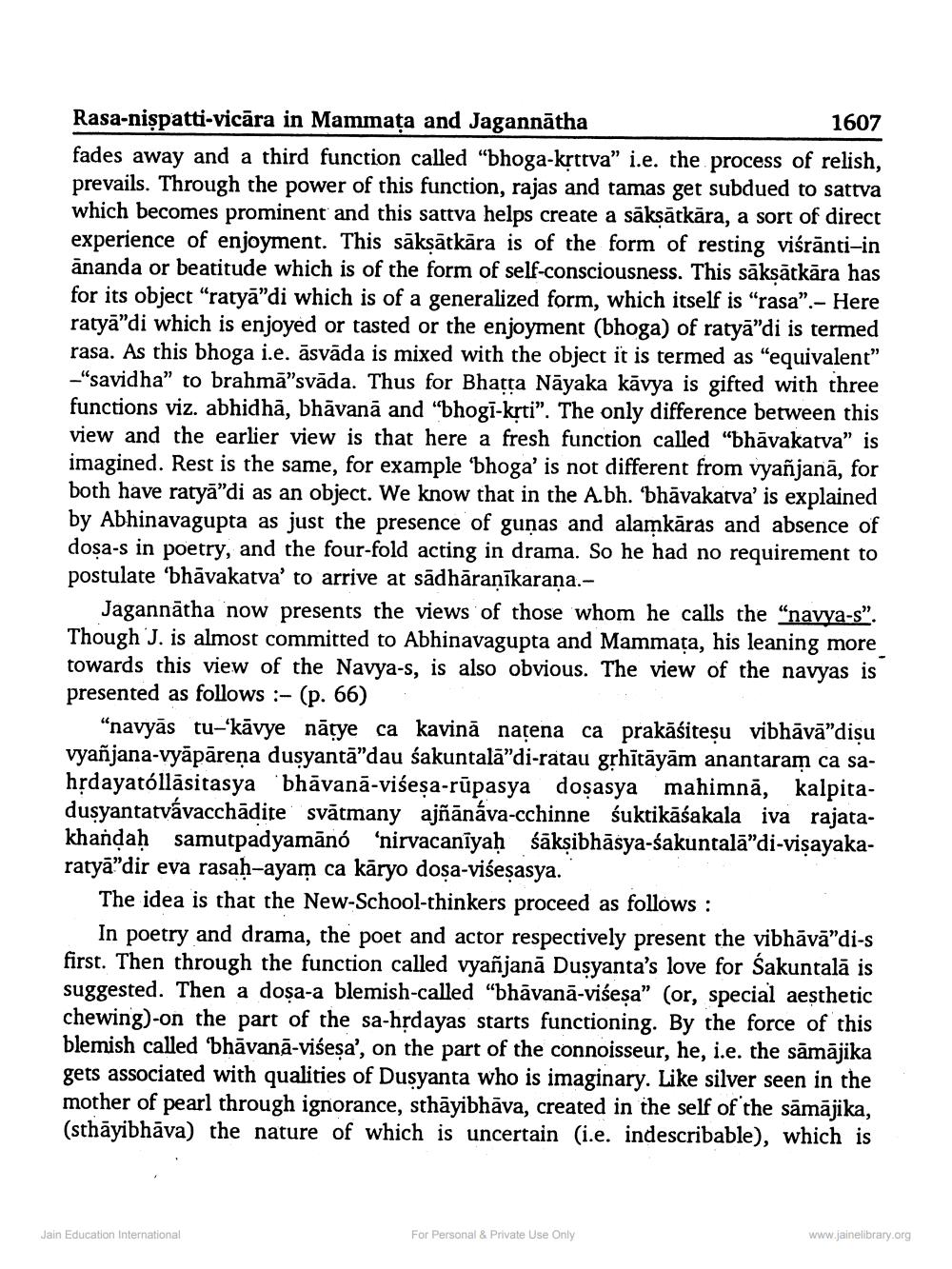________________
Rasa-nişpatti-vicāra in Mammața and Jagannātha
1607 fades away and a third function called "bhoga-krttva" i.e. the process of relish, prevails. Through the power of this function, rajas and tamas get subdued to sattva which becomes prominent and this sattva helps create a sāksātkāra, a sort of direct experience of enjoyment. This sākṣātkāra is of the form of resting viśrānti-in ānanda or beatitude which is of the form of self-consciousness. This sāksātkāra has for its object "ratyā”di which is of a generalized form, which itself is "rasa”.- Here ratyā"di which is enjoyed or tasted or the enjoyment (bhoga) of ratyā"di is termed rasa. As this bhoga i.e. āsvāda is mixed with the object it is termed as “equivalent” -"savidha" to brahmā"svāda. Thus for Bhatta Nāyaka kāvya is gifted with three functions viz. abhidhā, bhāvanā and "bhogi-krti". The only difference between this view and the earlier view is that here a fresh function called "bhāvakatva” is imagined. Rest is the same, for example 'bhoga' is not different from vyañjanā, for both have ratyā"di as an object. We know that in the Abh. 'bhāvakatva' is explained by Abhinavagupta as just the presence of guņas and alamkāras and absence of dosa-s in poetry, and the four-fold acting in drama. So he had no requirement to postulate 'bhāvakatva' to arrive at sādhāranīkarana.
Jagannātha now presents the views of those whom he calls the "navya-s”. Though J. is almost committed to Abhinavagupta and Mammata, his leaning more towards this view of the Navya-s, is also obvious. The view of the navyas is presented as follows :- (p. 66)
"navyās tu-kāvye nātye ca kavină natena ca prakāśitesu vibhāvā"disu vyañjana-vyāpāreņa dusyantā"dau śakuntalā”di-ratau grhītāyām anantaram ca sahỉdayatollāsitasya 'bhāvanā-viśeşa-rūpasya dosasya mahimnā, kalpitadusyantatvávacchadite svātmany ajñānáva-cchinne śuktikāśakala iva rajatakhandaḥ samutpadyamānó ‘nirvacanīyaḥ śākṣibhāsya-śakuntalā”di-visayakaratyā'dir eva rasaḥ-ayam ca kāryo dosa-vićeșasya.
The idea is that the New-School-thinkers proceed as follows:
In poetry and drama, the poet and actor respectively present the vibhāvā"di-s first. Then through the function called vyañjanā Dusyanta's love for Śakuntalā is suggested. Then a dosa-a blemish-called "bhāvanā-višesa" (or, special aesthetic chewing)-on the part of the sa-hrdayas starts functioning. By the force of this blemish called 'bhāvanā-višesa', on the part of the connoisseur, he, i.e. the sāmājika gets associated with qualities of Dusyanta who is imaginary. Like silver seen in the mother of pearl through ignorance, sthāyibhāva, created in the self of the sāmājika, (sthāyibhāva) the nature of which is uncertain (i.e. indescriba
Jain Education International
For Personal & Private Use Only
www.jainelibrary.org




